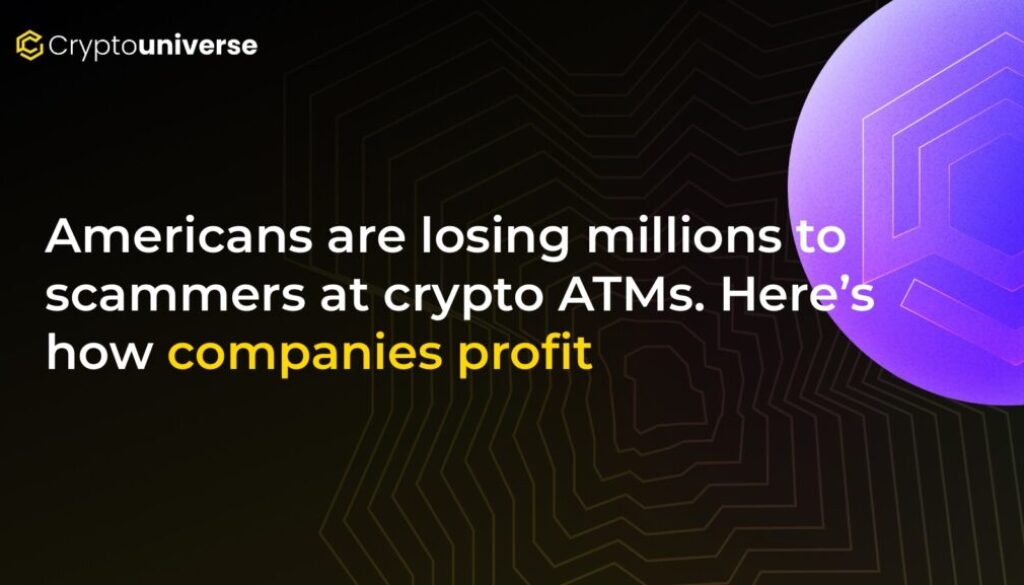Americans are losing millions to scammers at crypto ATMs. Here’s how companies profit

The Convenience Store Crime Scene
Tucked inside a busy convenience store in Prescott, Arizona, next to an ice cream cooler, sits a machine that looks like a regular ATM. It has a touchscreen, a keypad, and a slot for cash. But this machine is different. It’s a crypto ATM, and for many, it has become a gateway to financial ruin.
In a span of just four days this summer, this single machine was used to defraud four people of their life savings. Jeanne lost $18,000. Patricia, $3,000. Heather was fleeced of $25,000, and Lily lost nearly $8,000. In total, this one crypto ATM has been linked to at least $118,000 in theft since last year.
The story is tragically common. Victims are tricked by sophisticated scammers into believing they face a dire crisis—legal trouble, a hacked bank account, or an urgent debt. The solution, they are told, is to rush to a nearby crypto ATM, feed in thousands of dollars in cash, and send it to a designated crypto wallet. In an instant, the money is gone, routed to the criminals’ accounts, often overseas.
While law enforcement is aware of this surging crime wave, they are often powerless to stop it. What’s more frustrating for investigators is the role of the U.S. companies that own and operate these machines. A recent investigation reveals these companies are not just bystanders; they are profiting from the fraud while doing little to prevent it and, in some cases, actively hindering efforts to help victims.
The Alarming Rise of Crypto ATM Scams
Crypto ATMs offer a way to convert physical cash into digital currency like Bitcoin. While they provide an alternative to online exchanges, their convenience comes at a steep price—both in fees and in risk. Scammers have identified these machines as the perfect tool for their schemes, offering a fast, anonymous way to turn a victim’s cash into hard-to-trace cryptocurrency.
The numbers are staggering. According to the FBI, Americans lost approximately $240 million to crypto ATM scams in the first half of this year alone, a rate nearly double that of last year. The Federal Trade Commission (FTC) reports a nearly tenfold increase in these fraud losses since 2020, jumping from $12 million to $114 million in 2023.
These aren’t isolated incidents. They are part of a widespread, organized criminal enterprise that preys on fear and urgency, with the crypto ATM serving as the getaway vehicle.
The Scammer’s Playbook: How a Simple Phone Call Leads to Ruin
The scams almost always follow a similar script, designed to create panic and override rational thinking. Here’s how it typically unfolds:
- The Hook: Scammers contact victims, often the elderly, through phone calls, pop-up ads, or emails. They pose as law enforcement, tech support from a major company, or even a bank employee, fabricating an emergency that requires immediate payment.
- The Threat: They might claim the victim will be arrested, their bank account is compromised, or that sensitive personal information will be leaked. The goal is to induce a state of high-stress duress.
- The Solution: The scammer, acting as a helpful authority figure, guides the victim step-by-step. They instruct them to withdraw large sums of cash from their bank and drive to a specific location—usually a gas station or convenience store with a crypto ATM.
- The Heist: The victim is coached through the entire ATM transaction, told to ignore on-screen warnings, and directed to send the newly purchased crypto to a QR code or wallet address provided by the scammer. Once the transaction is confirmed on the blockchain, the money is irreversible.
Shelby ‘Gus’ Cason, a 69-year-old from Iowa, fell victim to this exact playbook. Panicked by a threat of arrest, he was directed to deposit $15,000 into a Bitcoin ATM. “I was under duress big time,” he recalled. Even when local police seized the cash from the machine, the ATM company, Bitcoin Depot, fought them in court and won. Cason never got his money back.
Following the Money: How Crypto ATM Companies Profit from Fraud
While crypto ATM companies publicly state that scams represent a tiny fraction of their business, evidence from numerous state attorneys general and financial regulators suggests otherwise. In Washington D.C., a lawsuit alleged that over 90% of deposits in one company’s ATMs came from fraud. Iowa’s attorney general claimed that scams accounted for more than half of all money processed by Bitcoin Depot in the state over a three-year period.
So, how do
Exorbitant Fees and Hidden Markups
Crypto ATM operators make money not just from service fees but from massive markups on the price of cryptocurrency. It’s common for these companies to sell Bitcoin or other cryptos at a rate 20% to 30% higher than the market price.
Consider a real transaction receipt from Bitcoin Depot. For a $4,300 cash deposit, the customer received only about $3,450 worth of Bitcoin. The company pocketed around $850 from the inflated exchange rate, on top of a small service fee. When a scam victim deposits their life savings, the company profits handsomely from their misfortune.
A Battle Against Victims and Law Enforcement
Instead of aiding victims, these companies often create more obstacles. Their official policy is typically that all transactions are final and non-refundable. While some claim to have “secret” refund policies for transaction fees, many victims who have reached out for help are rebuffed or ignored.
When police manage to seize cash from an ATM on behalf of a victim, the companies aggressively fight back in court to reclaim the money, arguing the transaction was authorized by the user. In one shocking instance, after winning a court case to retrieve seized funds, a Bitcoin Depot manager sent an email to the sheriff’s office saying, “Glorious day,” and later mailed the police department a copy of the U.S. Constitution, suggesting they needed to read it.
The Fight for Regulation: Lobbyists vs. Consumer Protection
As scams escalate, state lawmakers have attempted to introduce consumer protections, such as daily transaction limits and mandatory refund policies for fraud victims. However, the crypto ATM industry has deployed an army of over 150 lobbyists across the country to weaken or kill these bills.
In states like Minnesota, a proposed $1,000 daily transaction limit was successfully watered down to a $2,000 limit that only applies to new users—a loophole scammers quickly exploited. In Missouri, lawmakers passed regulations that almost perfectly matched model legislation written and pushed by the industry itself, with no transaction limits or refund requirements.
This powerful lobbying effort ensures that regulations often favor the companies’ bottom line over the financial safety of consumers, leaving a patchwork of inconsistent and often ineffective laws across the nation.
How to Protect Yourself from Crypto ATM Scams
Awareness is the best defense against these predatory schemes. If you or someone you know is ever instructed to make a payment using a crypto ATM, remember these critical red flags:
- Urgent Demands for Payment: Legitimate organizations like the IRS, law enforcement, or tech support companies like Microsoft will never demand immediate payment over the phone, especially not with cryptocurrency.
- Instructions to Lie or Be Secretive: Scammers often tell their victims not to talk to anyone about the transaction, including bank tellers or family members. This is a massive red flag.
- Payment via Crypto ATM, Gift Cards, or Wire Transfers: These payment methods are favorites of scammers because they are difficult to trace and nearly impossible to reverse. Any request for payment using these methods for debts or fines is a scam.
- Threats and Intimidation: If someone is threatening you with arrest, legal action, or public embarrassment to coerce a payment, hang up immediately and contact local law enforcement directly.
Conclusion: A Broken System in Need of a Fix
The proliferation of crypto ATMs has created a fertile ground for criminals, facilitated by a system that seems to prioritize profits over protection. Victims like Gus Cason are left feeling “screwed” twice—first by the scammer, and then by the company that profited from his loss.
Until there is meaningful, consumer-focused regulation and a greater commitment from the crypto ATM industry to prevent fraud, these machines will continue to serve as conduits for crime, draining millions from the pockets of vulnerable Americans.


